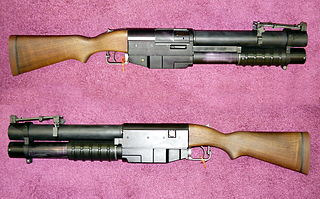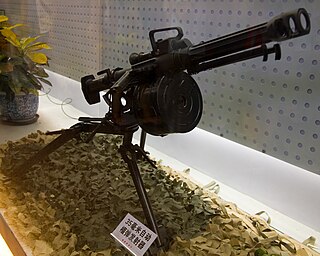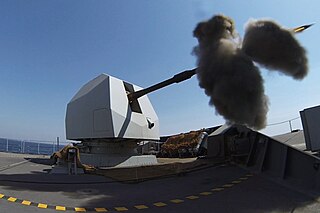
Armour-piercing ammunition (AP) is a type of projectile designed to penetrate armour protection, most often including naval armour, body armour, vehicle armour.

A grenade launcher is a weapon that fires a specially designed, large-caliber projectile, often with an explosive, smoke, or gas warhead. Today, the term generally refers to a class of dedicated firearms firing unitary grenade cartridges. The most common type are man-portable, shoulder-fired weapons issued to individuals, although larger crew-served launchers are issued at higher levels of organization by military forces.

The Objective Individual Combat Weapon or OICW was the next-generation service rifle competition that was under development as part of the United States Army OICW program; the program was eventually discontinued without bringing the weapon out of the prototype phase. The acronym OICW is often used to refer to the entire weapons program.

The M203 is a single-shot 40 mm under-barrel grenade launcher designed to attach to a rifle. It uses the same rounds as the older stand-alone M79 break-action grenade launcher, which utilizes the high-low propulsion system to keep recoil forces low. Quite versatile and compatible with many rifle models, the M203 was originally designed for the U.S. M16 and its carbine variant, the M4. The launcher can also be mounted onto a C7, a Canadian version of the M16 rifle; however, this requires the prior removal of the bottom handguard.

The Mk 19 grenade launcher is an American 40 mm belt-fed automatic grenade launcher that was first developed during the Vietnam War.

The M79 grenade launcher is a single-shot, shoulder-fired, break-action grenade launcher that fires a 40×46mm grenade, which uses what the US Army calls the High-Low Propulsion System to keep recoil forces low, and first appeared during the Vietnam War. Its distinctive report has earned it colorful nicknames, such as "Thumper", "Thump-Gun", "Bloop Tube", "Big Ed", "Elephant Gun", and "Blooper" among American soldiers as well as "Can Cannon" in reference to the grenade size; Australian units referred to it as the "Wombat Gun". The M79 can fire a wide variety of 40 mm rounds, including explosive, anti-personnel, smoke, buckshot, flechette, and illumination. While largely replaced by the M203, the M79 has remained in service in many units worldwide in niche roles.

The United States military has developed a number of Helicopter Armament Subsystems since the early 1960s. These systems are used for offensive and defensive purposes and make use of a wide variety of weapon types including, but not limited to machine guns, grenade launchers, autocannon, and rockets. Various systems are still in use, though many have become obsolete.
The Advanced Individual Combat Weapon (AICW) was an Australian prototype combination assault rifle and grenade launcher developed as a technology demonstrator. The AICW combined a standard 5.56 mm assault rifle based on the successful F88 Austeyr with a superposed load grenade launcher developed by Metal Storm.

The XM307 Advanced Crew Served Weapon (ACSW) was a developmental 25 mm belt-fed automatic grenade launcher with programmable airburst capability. It is the result of the OCSW or Objective Crew Served Weapon project. It is lightweight and designed to be two-man portable, as well as vehicle mounted. The XM307 can kill or suppress enemy combatants out to 2,000 meters (2,187 yd), and destroy lightly armored vehicles, watercraft, and helicopters at 1,000 meters (1,094 yd). The project was canceled in 2007.

The China Lake pump-action grenade launcher or NATIC is a pump-action grenade launcher that was developed by the Special Projects Division of the Naval Air Weapons Station China Lake, which provided equipment to United States Navy SEALs.

The QLZ-87 35×32mmSR automatic grenade launcher (AGL) is an air-cooled, gas operated fully automatic weapon and is crew transportable with limited amounts of ammunition. Unusual for handheld grenade launchers, the QLZ-87 fires high-velocity grenades of 35x32 mmSR caliber, which provides longer range and flatter firing trajectory.

The HK69A1 is a 40 mm grenade launcher developed and produced by the German arms manufacturer Heckler & Koch (H&K). The weapon was designed to engage enemy troops and strongpoints out to a distance of 350 m; it can also be used to deploy smoke grenades and illumination flares.

The 4.5 inch Mark 8 is a British naval gun system which currently equips the Royal Navy's destroyers and frigates, and some British destroyers and frigates sold to other countries.
The MEI Hellhound 40 mm low-velocity multi-purpose grenade is a fixed-type munition designed to be fired from a 40×46mm grenade launcher such as the M79, M203, M320, or Milkor MK-1. The round consists of an A5 filled metal projectile body with a rotating band, a point initiating-base detonating fuze with safe and arm technology, and a cartridge case assembly. Upon impact with the target, the firing pin is driven into the detonator, which in turn initiates the spit backcharge, producing a jet which initiates the explosive train from the base forward, resulting in an armor-piercing jet of molten metal and fragmentation of the projectile body. The MEI Hellhound uses the same high-low propulsion system as other popular 40 mm grenade launchers, which keeps the recoil forces in line with other infantry small arms.
In India, the Armament Research & Development Establishment (ARDE) is a laboratory of the Defence Research and Development Organisation (DRDO). Located in Pune, it is the main DRDO lab involved in the development of conventional armaments.
The high–low system is a design of cannon and anti-tank warfare launcher using a smaller high-pressure chamber to store propellant. It allows a much larger projectile to be launched without the heavy equipment usually needed for large caliber weapons. When the propellant is ignited, the higher pressure gases are bled out through vents at reduced pressure to a much larger low pressure chamber to push a projectile forward. The high-low system allows the weight of the weapon and its ammunition to be reduced significantly. Production cost and time are drastically lower than for standard cannon or other small-arm weapon systems firing a projectile of the same size and weight. It has a far more efficient use of the propellant, unlike earlier recoilless weapons, where most of the propellant is expended to the rear of the weapon to counter the recoil of the projectile being fired.
The MEI Mercury is a family of medium-range low-impulse 40mm grenade (40×46mmSR) developed by Martin Electronics, Inc. (MEI) that can reach out to 800 meters. The rounds are a fixed type ammunition designed to be fired from a 40 mm Grenade Launcher such as the M79, M203, M320, or Milkor MK-1.

The Milkor MGL is a lightweight 40 mm six-shot revolver-type grenade launcher developed and manufactured in South Africa by Milkor (Pty) Ltd. The MGL was demonstrated as a concept to the South African Defence Force (SADF) in 1981. The MGL was then officially accepted into service with the SADF as the Y2. After its introduction in 1983, the MGL was gradually adopted by the armed forces and law enforcement organizations of over 50 countries. Total production since 1983 has been more than 50,000 units.
The Milkor 40mm UBGL grenade launcher is a lightweight single-shot, underslung grenade launcher designed and developed in South Africa by Milkor (Pty) Ltd. It can be attached to most modern assault weapons and rifles using a Picatinny rail system. The UBGL is capable of firing standard 40mm rounds including illumination and observation rounds. Clip-on, clip-off mechanism allows the UBGL to be fitted, with an additional recoil buffer, to any weapon fitted with a Picatinny rail.












